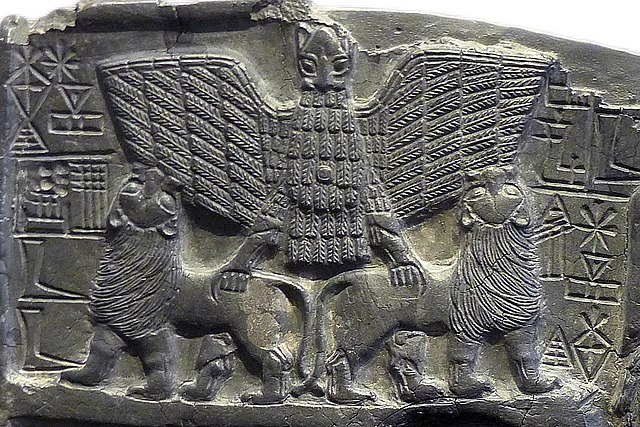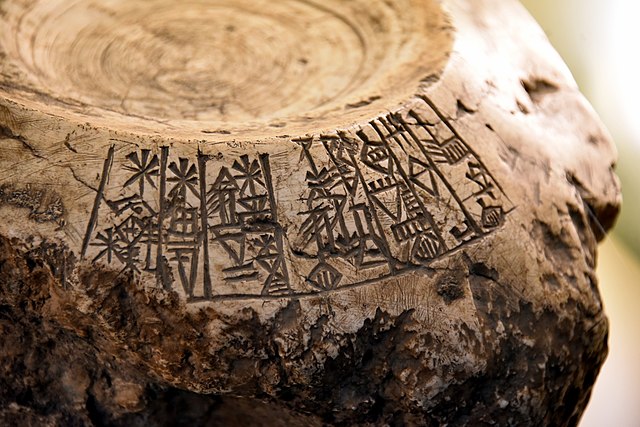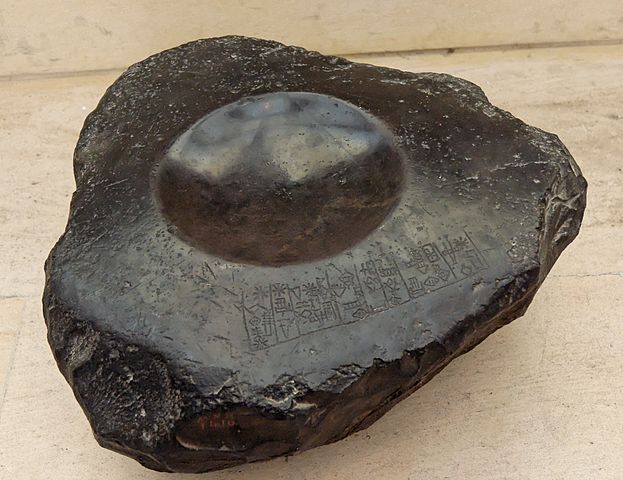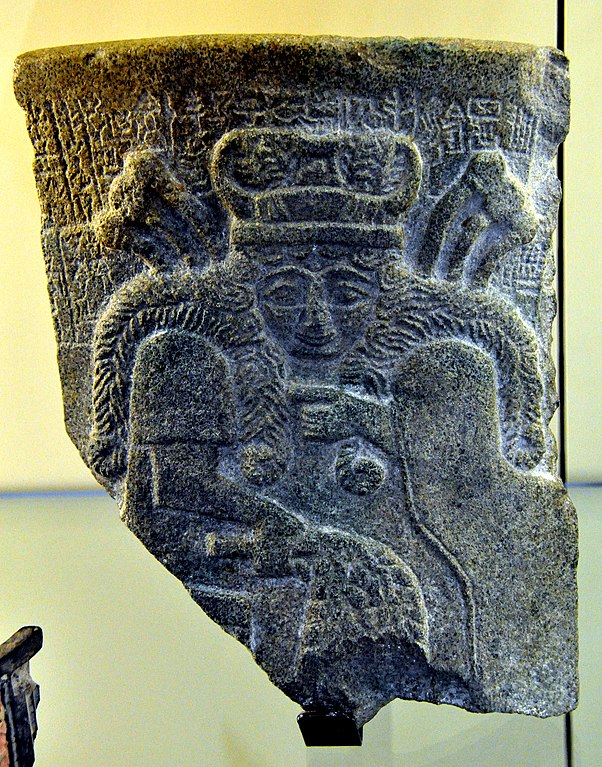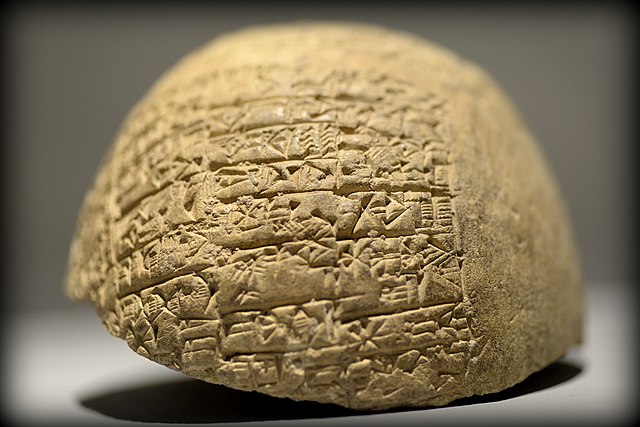
| ENTEMENA
Statue of Entemena, Iraq Museum. The statue has a long inscription on the back dedicated to Enlil
Entemena was king of Lagash, circa 2400 BC
Entemena, also called Enmetena (Sumerian: EN-TE-ME-NA), flourished 2400 BC, was a son of Yuwanashwa / En-anna-tum I, and he re-established Lagash as a power in Sumer. He defeated Il, king of Umma, in a territorial conflict, through an alliance with Lugal-kinishe-dudu of Uruk, successor to Enshakushanna, who is in the king list. The tutelary deity Shul-utula was his personal deity. According to Jones (2012), his rule lasted 29 years.
Territory
:
"At that time, Entemena built and reconstructed the E-mush, his beloved temple, in Badtibira, for the god Lugalemush, (and) he set free the citizens of Uruk, Larsa, and Badtibira."
- Inscriptions of Entemena.
Alliance treaty :
"Entemena
Ensi Lagash-ki" on the Treaty Cone of Entemena, king of Lagash,
to god of Bad-Tibira, about the peace treaty between Lagash and
Uruk. This text is the oldest known diplomatic document. Dated circa
2400 BC. British Museum.
1st
line :
Another example of the foundation nail dedicated by Entemena, king of Lagash, to god of Bad-Tibira, about the peace treaty between Lagash and Uruk. Louvre Museum
Cuneiforms for "Entemena" on the Harvard cone Territorial conflict with King Il of Umma :
"Entemena,
Governor of Lagash"
Entemena
ensi Lagash-ki
Entemena entered in a territorial conflict with Il, king of Umma, as mentioned in the "war inscription" on his cone in the Louvre Museum :
"He (Il, Governor of Umma) diverted water from the boundary-channel of Ningirsu and the boundary-channel of Nanshe (...). When because of those channels, Enmetena, the governor of Lagash, sent envoys to Il, Il, the governor of Umma, who steals fields (and) speaks evil, declared: ‘The boundary-channel of Ningirsu (and) the boundary-channel of Nanshe are mine! I will shift the boundary-levee from Antasura to Edimgalabzu!’ But Enlil (and) Ninhursang did not give it to him."
Il was defeated by Entemena, who had sought the aid of Lugal-kinishe-dudu of Uruk, successor to Enshakushanna, who is in the king list.
War
inscription by Entemena of Lagaš :
Cone of Entemena
Cone of Enmetena, king of Lagash, Room 236 Reference AO 3004, Louvre Museum (upside down)
Transcription of the cone of Entemena
I.1 - 7 :
"Net cylinder" of Entemena, the second known cylinder describing the border conflict between Lagash and Umma. The textual content is identical to the cone cylinder The "Net cylinder" of Entemena is a cylinder of a peculiar design, with a net pattern on the bottom, which is the second known cylinder describing the border conflict between Lagash and Umma. The content is identical to the cone cylinder. It is located in the Yale Babylonian Collection.
Full text of the War inscription by Entemena, in the Net Cylinder
Mesilim Lugal Kish-ki, "Mesilim, King of Kish", on the "Net Cylinder" of Entemena Statue of Entemena :
The statue of Entemena back in the National Museum of Iraq, following its rescue Entemena has one of the earliest statues of a known king from Mesopotamia. It is made of diorite, and is 76 centimeters tall. Entemena, although ruler of the city-state of Lagash, wears the typical dress of a devotee: a kaunakes fleeced skirt with a tassel in the back. He is clasping his hands at the chest, in a typical pose of perpetual attendance before the deity.
The statue of Entemena reflects a style of which a few other examples are known from Mesopotamia, such as the statue of Ikun-Shamash from Mari, the statue of Enzi from Der, or the statue of Lugal-dalu, which still has its head intact.
The statue of Entemena has a very long cuneiform inscription on the side (right arm) and on the back. It includes the names and titles of Entemena, and the mention "Enlil (the supreme Sumerian god) loves Entemena".
The statue was housed in the National Museum of Iraq. In May 2003 the statue was stolen during the 2003 invasion of Iraq. It was found in New York and returned in 2010.
Detail showing the cuneiform inscription on the right upper arm of the statue of Entemena
Detail showing the cuneiform inscription on the back of the upper torso of the statue of Entemena
"Entemena ensi of Lagash" on the right shoulder of the statue of Entemena Silver vase of Entemena :
Silver vase, with decorated panels, inscribed with cuneiform around rim. Louvre Museum A tripod of silver dedicated by Entemena to his god is now in the Louvre. A frieze of lions devouring ibexes and deer, incised with great artistic skill, runs round the neck, while the eagle crest of Lagash adorns the globular part. The vase is a proof of the high degree of excellence to which the goldsmith's art had already attained. A vase of calcite, also dedicated by Entemena, has been found at Nippur. The inscription of the neck of the silver vase reads:
"For Ningirsu, the foremost warrior of Enlil. Entemena, the ensi of Lagash, whom Nanshe had chosen in her heart, the great ensi of Ningirsu, the son of Enannatum, the ensi of Lagash, made for Ningirsu, the king who loved him, a vase of pure silver and stone (?), out of which Ningirsu drinks, and brought it to the Ningirsu of the Eninnu, for his life. At that time, Dudu was the sanga of Ningirsu."
Cuneiform dedication on the vase of Entemena
Entemena vase inscription
Entemena vase motif, with the eagle of Lagash Foundation tablets :
A votive tablet of Entemena, made of alabaster, with its foundation nail. Museum of the Ancient Orient, Istanbul Several votive tablets in the name of Entemena are known. They usually records Entemena's name, title and filiation, and his accomplishment in establishing temples or devotional images. The tablets are often associated with a "foundation nail", called temen ("foundation") in Sumerian, which was inserted into the ground under the foundation of temples, together with the inscribed tablets and offerings such as jewelry or small statuettes of protective divinities.
An inscription of Entemena to Ningirsu: "... Entemena, ensi of Lagash, son of Enannatum, ensi of Lagash, grandson of Ur-Nanshe, king of Lagash ..."
Votive tablet of Entemena to Ningirsu: "... Entemena, ensi of Lagash, son of Enannatum, ensi of Lagash, grandson of Ur-Nanshe, king of Lagash ..."
Inscribed stone tablet of Entemena. Pergamon Museum Perforated plate of Dudu :
Votive plaque of Dudu, Priest of Ningirsu, during the reign of Entemena, Patesi of Shirpurla. Louvre Museum Another artifact related to Entemena is a votive plaque beating the name of Dudu, priest of Lagash for Ningirsu in Entemena's time. Dudu is known as priest of Lagash under Entemena from the last line of the inscription on the silver vase of Entemena. The plate was made out of bitumen, a rather distinctive feature, as most such plaques were made of limestone or gypsum. The plaque depicts various scenes: a standing man in a kaunakes holding a walking stick, a resting cow, and the symbol of Lagash: an eagle holding two lions, although the lions are uncharacteristically biting back at the wings of the eagle. A symbolic wave pattern at the bottom of the plate is thought to symbolize the flow of water.
It is inscribed with the following text: "For Ningirsu of the Eninnu, Dudu, priest of Ningirsu ... brought [this material] and fashioned it as a mace stand." The exact function of the plaque is unknown: it has been interpreted as a mace-holder, a plaque to be nailed into the wall of a temple, or a door panel.
The eagle, symbol of Lagash, at the time of Entemena
The resting cow Other
artifacts :
Detail of a door-socket, inscribed with the name of Entemena. Vorderasiatisches Museum, Germany
Tael (door socket) of Entemena, with cuneiform inscription. Louvre Museum
Entemena Ensi Lagashki, "Etemena, Ensi of Lagash"
Sumerian goddess Nisaba, the name of Entemena is inscribed, c. 2430 BC, from Iraq. Vorderasiatisches Museum, Germany
An Inscribed stand's head mentioning the name of Entemena, ruler of Lagash, c. 2400 BCE. Sulaymaniyah Museum, Iraq
Source :
https://en.wikipedia.org/ |
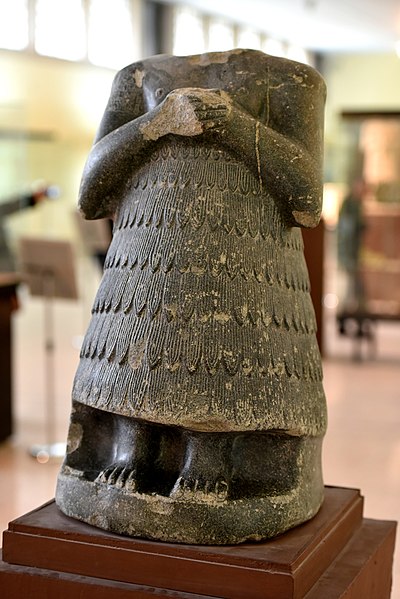
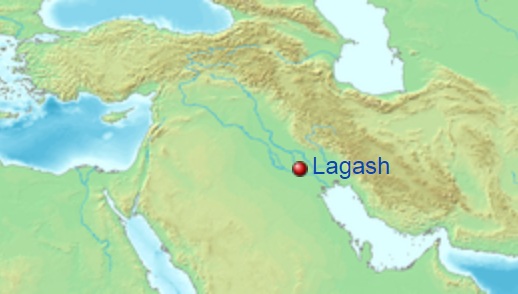

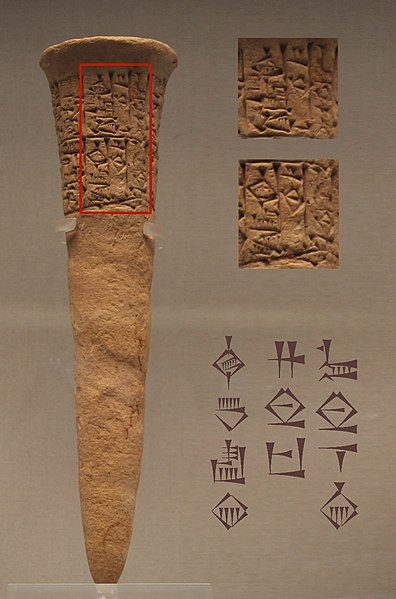
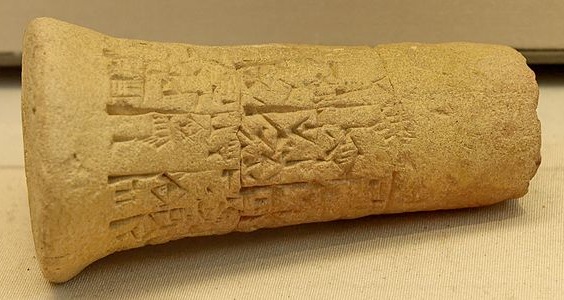
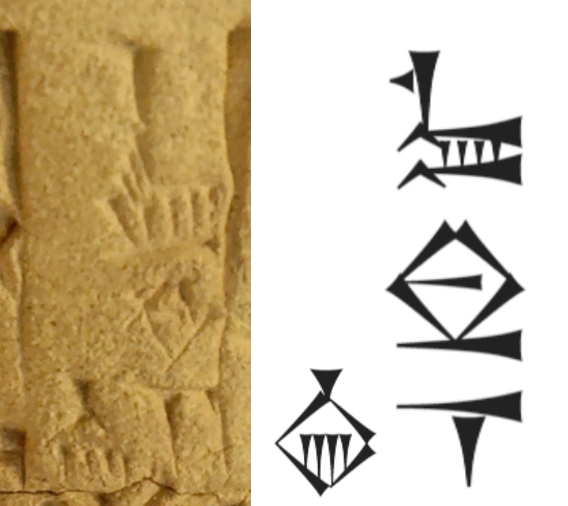
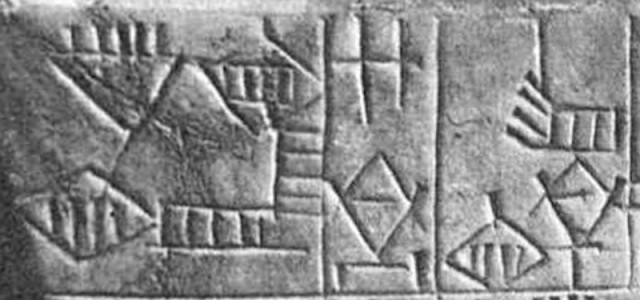

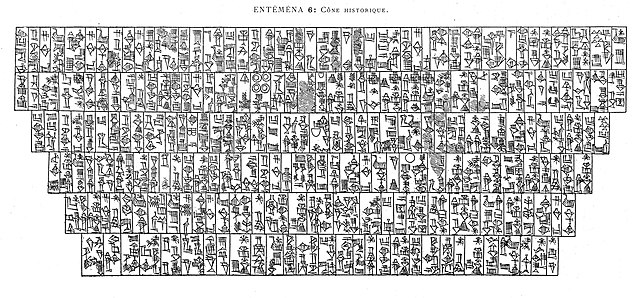


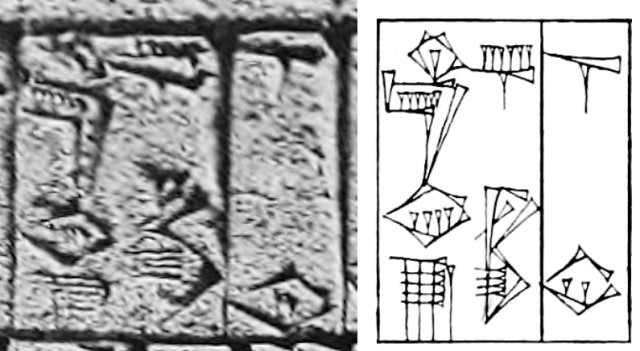
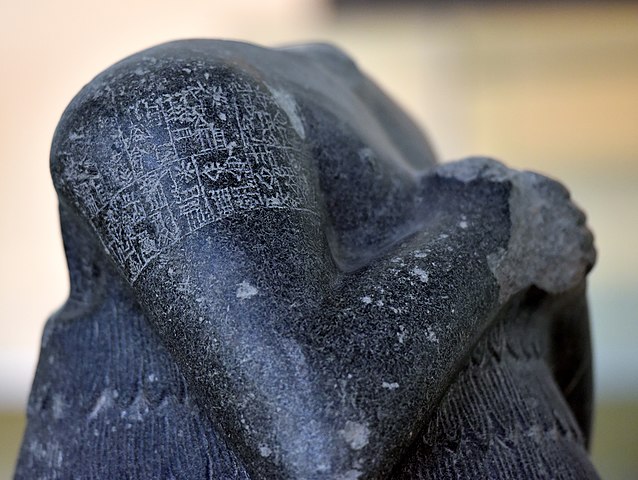
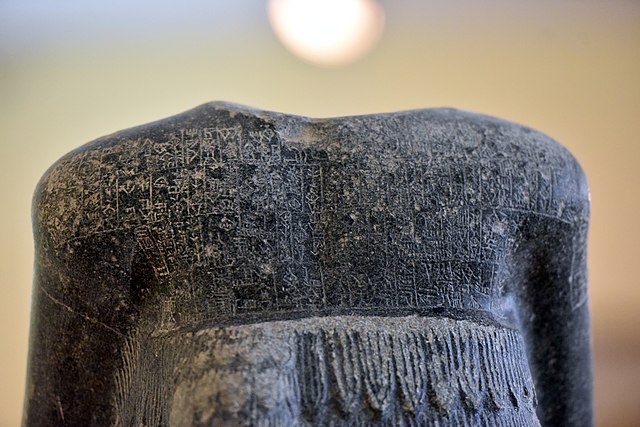
.jpg)

_circa_2400_BCE.jpg)

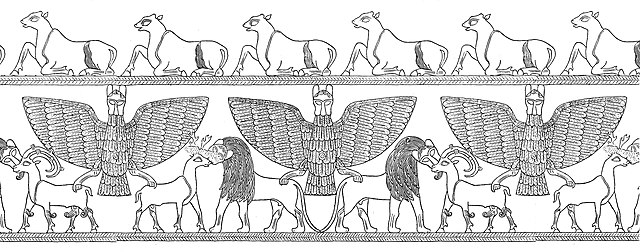
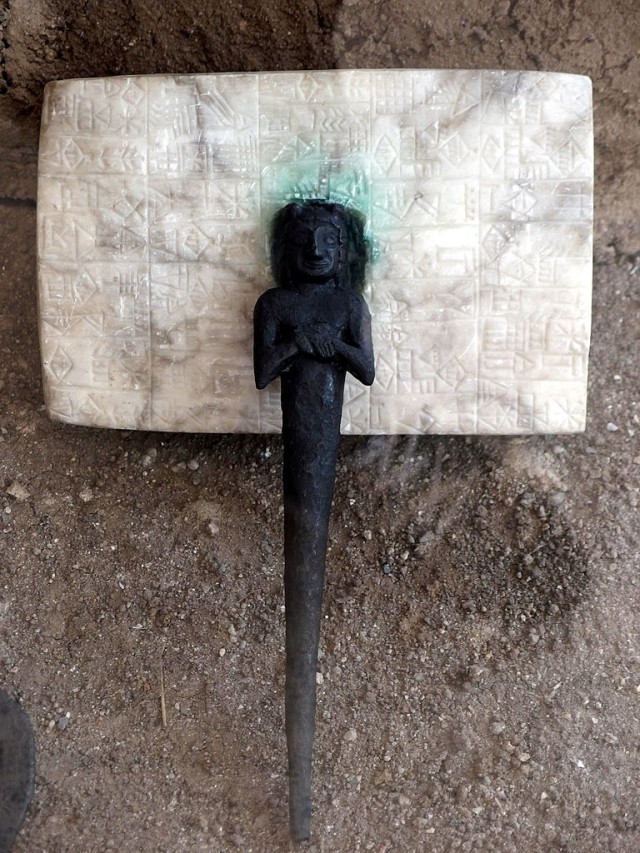
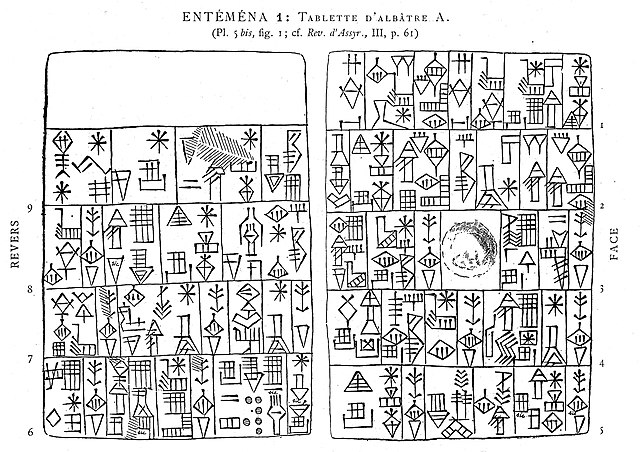
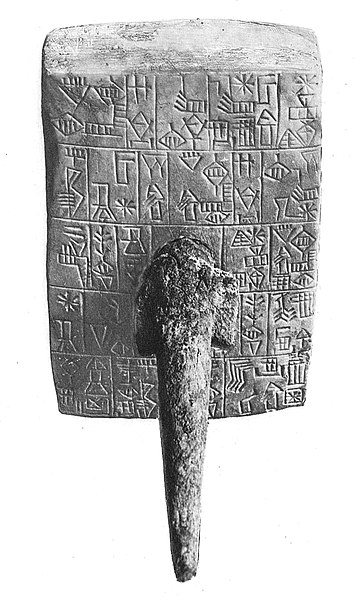

.jpg)
